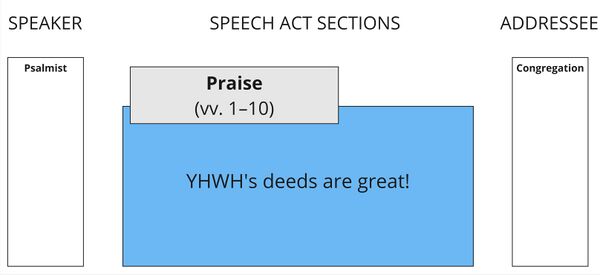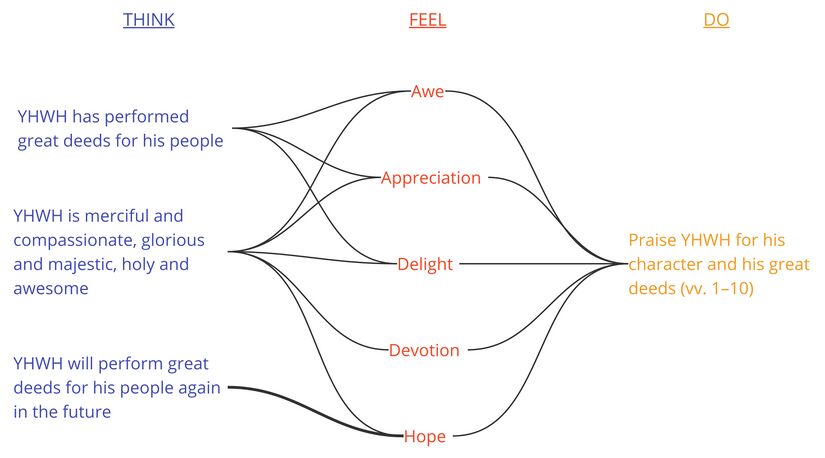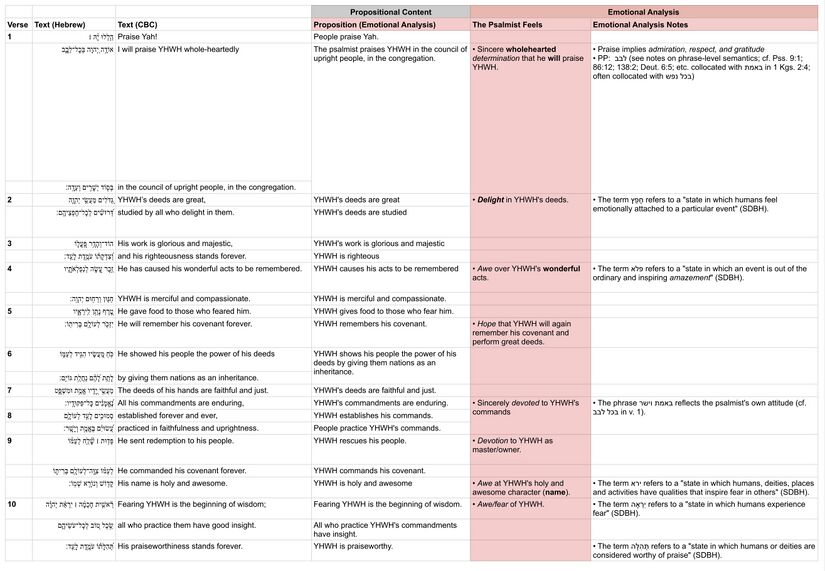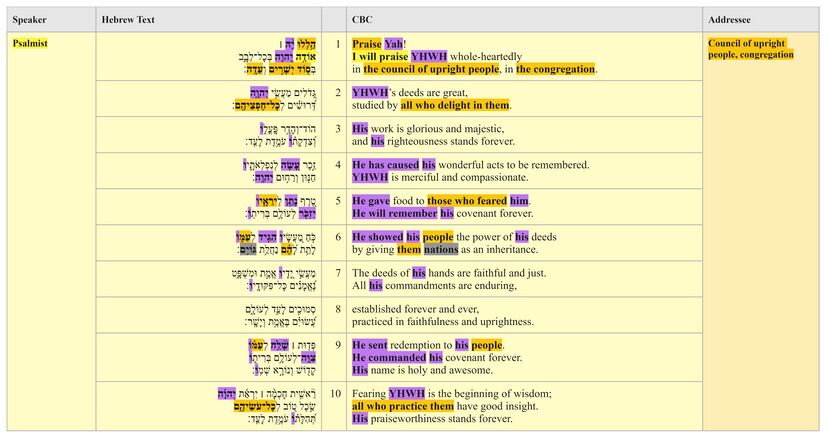Psalm 111 Discourse
About the Discourse Layer
Our Discourse layer includes four analyses: macrosyntax, speech act analysis, emotional analysis, and participant analysis. (For more information, click 'Expand' to the right.)
Macrosyntax
The macrosyntax layer rests on the belief that human communicators desire their addressees to receive a coherent picture of their message and will cooperatively provide clues to lead the addressee into a correct understanding. So, in the case of macrosyntax of the Psalms, the psalmist has explicitly left syntactic clues for the reader regarding the discourse structure of the entire psalm. Here we aim to account for the function of these elements, including the identification of conjunctions which either coordinate or subordinate entire clauses (as the analysis of coordinated individual phrases is carried out at the phrase-level semantics layer), vocatives, other discourse markers, direct speech, and clausal word order.
For a detailed explanation of our method, see the Macrosyntax Creator Guidelines.
Speech Act Analysis
The Speech Act layer presents the text in terms of what it does, following the findings of Speech Act Theory. It builds on the recognition that there is more to communication than the exchange of propositions. Speech act analysis is particularly important when communicating cross-culturally, and lack of understanding can lead to serious misunderstandings, since the ways languages and cultures perform speech acts varies widely.
For a detailed explanation of our method, see the Speech Act Analysis Creator Guidelines.
Emotional Analysis
This layer explores the emotional dimension of the biblical text and seeks to uncover the clues within the text itself that are part of the communicative intent of its author. The goal of this analysis is to chart the basic emotional tone and/or progression of the psalm.
For a detailed explanation of our method, see the Emotional Analysis Creator Guidelines.
Participant Analysis
Participant Analysis focuses on the characters in the psalm and asks, “Who are the main participants (or characters) in this psalm, and what are they saying or doing? It is often helpful for understanding literary structure, speaker identification, etc.
For a detailed explanation of our method, see the Participant Analysis Creator Guidelines.
Discourse Visuals for Psalm 111
Macrosyntax
Notes
Word Order
- v. 2a. The fronting of גְּדֹלִים is poetic (ג line of acrostic) and probably also information-structural. Although "YHWH's deeds" have not been mentioned until this point, they are implied by אודה יהוה in the previous verse—the word אודה means "action by which humans openly express recognition of what someone else has done or achieved" (SDBH, italics added). The fronted predicate thus "establishes... [the] state or features... of the discourse active subject of a verbless clause" (BHRG 47.3.2).
- v. 3a. The fronting of הוֹד־וְהָדָר is, like גְּדֹלִים, both poetic (ה line of acrostic) and information-structural (cf. BHRG 47.3.2).
- v. 4a. The fronting of the object זֵכֶר is probably poetic, fitting the acrostic structure (ז line). The placement of לְנִפְלְאֹתָיו at the end of the line, even though it modifies the זֵכֶר, might be due to the length of לְנִפְלְאֹתָיו.
- v. 4b. The fronting of חַנּוּן וְרַחוּם is poetic, and, like the other verbless clauses in the psalm (vv. 2a, 3a, 9c, 10a), probably also information–structural (cf. BHRG 47.3.2).
- v. 5a. The fronting of the object טֶרֶף is poetic, fitting the acrostic structure (ט line).
- v. 5b. The adverbial לְעוֹלָם is placed before the object, probably to stress YHWH's ongoing commitment to his covenant: YHWH's covenant faithfulness is not just a matter of the past (cf. v. 5a). Rather, he will remember his covenant forever.
- v. 6a. The fronting of כֹּחַ מַעֲשָׂיו is probably poetic, fitting the acrostic structure (כ line).
- v. 7b. The fronting of the predicate נֶאֱמָנִים is poetic, both fitting the acrostic (נ line) and forming a chiasm in v. 7: S SC [אמת] // SC [אמן] S]).
- v. 9a. The fronting of the object פְּדוּת is poetic, both fitting the acrostic (פ line) and strengthening a correspondence with v. 6a (כֹּ֣חַ מַ֭עֲשָׂיו הִגִּ֣יד לְעַמּ֑וֹ), which also has a fronted object and the exact phrase לְעַמּוֹ (see poetic structure) (cf. Lunn 2006:327 "DEF").
- v. 9b. לְעוֹלָם (see v. 5b)
- v. 9c. The fronting of קָדוֹשׁ וְנוֹרָא is poetic (ק line of acrostic) and, like many of the other verbless clauses in the psalm (vv. 2a, 3a, 4b, 10a), probably also information structural (cf. BHRG 47.3.2).
- v. 10a. The fronting of רֵאשִׁית חָכְמָה is poetic (ר line of acrostic) and, like many of the other verbless clauses in the psalm (vv. 2a, 3a, 4b, 9c), probably also information structural (cf. BHRG 47.3.2). The subject יִרְאַת יְהוָה was implied in the previous line (נוֹרָא) and is therefore active in the discourse.
Speech Act Analysis
Summary Visual
Speech Act Chart
Emotional Analysis
Summary visual
Emotional Analysis Chart
Participant analysis
There are 3 participants/characters in Psalm 111:
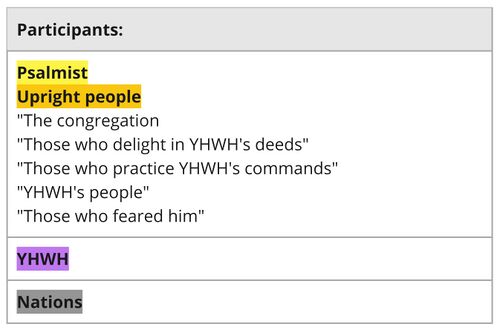
- Psalmist/Upright People: While the first-person singular reference in v. 1 constitutes a distinct participant, the psalmist presents himself as being present with the upright people, in the congregation (v. 1c). Thus, the psalmist describes himself as a subset of the upright people.
Participant Relations Diagram
The relationships among the participants may be abstracted and summarized as follows:
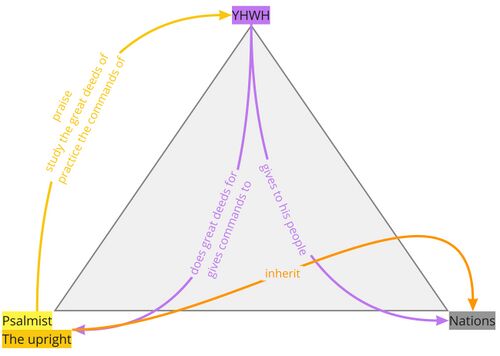

Participant Analysis Table
Notes
- v. 10: תְּהִלָּתוֹ "his praise" — YHWH or righteous person?
- The 3ms suffix on תְּהִלָּתוֹ might refer either to YHWH or to a person who fears YHWH and keeps his commands.
- The suffix probably refers to YHWH, who is the topic of the psalm and the referent of every other 3ms suffix. The correspondence between v. 10c and v. 3b and the inclusio of v. 1 (אוֹדֶה) and v. 10 (תְּהִלָּתוֹ) also support identifying YHWH as the subject.[1]
- Some scholars have argued that the 3ms suffix refers to a person who fears YHWH, either as an objective genitive ("his praise" = "the praise which he receives")[2] or a subjective genitive ("his praise" = "the praise which he gives").[3] But if this were the case, then we might have expected a 3mp suffix.
Distribution Table
Notes
- vv. 7–8: These verses are noteworthy, in that they do not contain any predicative participants (references to YHWH only occur as possessive suffixes).
Bibliography
- Allen, Leslie. 2002. Psalms 101-150. Vol. 3. Revised edition. Word Biblical Commentary 21. Waco: Word Books.
- Baethgen, Friedrich. 1904. Die Psalmen. Göttingen: Vandenhoeck und Ruprecht.
- Delitzsch, Franz. 1877. Biblical Commentary on the Psalms: Vol. 3. Edinburgh: T&T Clark.
- Hossfeld, Frank-Lothar, and Erich Zenger. 2011. Psalms 3: A Commentary on Psalms 101-150. Edited by Klaus Baltzer. Translated by Linda M. Maloney. Hermeneia. Minneapolis, MN: Fortress.
- Scoralick, Ruth. 1997. “Psalm 111 : Bauplan Und Gedankengang.” Biblica 78, no. 2 : 190–205.

